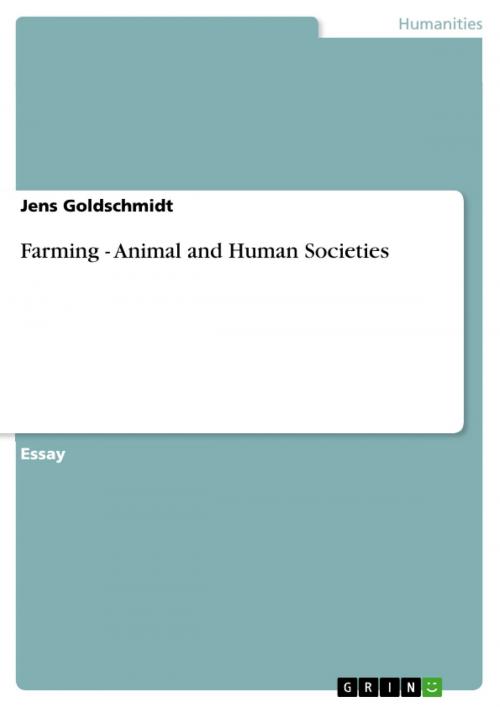| Author: | Jens Goldschmidt | ISBN: | 9783640985814 |
| Publisher: | GRIN Verlag | Publication: | August 16, 2011 |
| Imprint: | GRIN Verlag | Language: | English |
| Author: | Jens Goldschmidt |
| ISBN: | 9783640985814 |
| Publisher: | GRIN Verlag |
| Publication: | August 16, 2011 |
| Imprint: | GRIN Verlag |
| Language: | English |
Essay from the year 2009 in the subject Social Studies (General), grade: 2,3, Massey University, New Zealand (-), course: Animal and Human Societies, language: English, abstract: The following essay is about farming and it consists of four parts. At first I will illustrate the processes that have taken place in the transition from family farming to industrial livestock farming. The second part will be about the economic advantages modern farming implies for humans and the negative influences it has on animals. Thirdly, I will introduce some measures that have been taken over the last few decades to reconcile the human benefits of such farming methods with the suffering they cause to animals. Finally, I will show that some resulting compromises between commerce and the animal welfare movement have marked a step forward, but that there is still a lot to be done in order to enhance the life of farm animals. Farm animals are being taken off the fields and the old lichen covered barns are being replaced by gawky, industrial type buildings into which the animals are put. [...] The sense of unity with [the farmer's] stock which characterizes the traditional farmer is condemned as being uneconomic and sentimental. [...] Factory farm animals are assessed purely for their ability to convert food into flesh, or `saleable products'. (p. 1) This is how Ruth Harrison (1964) describes the shift from traditional family farming to modern farming methods like industrial livestock farming. Having a closer look on this shift, one can see that in early modernity from about 1500 to 1800 farm animals were part of a farm's community. They lived much closer to their owners than nowadays, it was even common to live with ones animals under the same roof in so called 'long-houses'. Furthermore, most farm animals were given names and some farmers knew their cattle so detailed, that they were able to identify them by their hoof prints (Thomas, 1983, p. 94). Besides, animals served not only as food, but also as instruments for labour on the acre, and most farmers bred animals for personal consumption or for local markets (Thomas, 1983). This rather idyllic method of farming began dying out in the middle of the 19th century, when the industrial revolution started in western Europe. [...]
Essay from the year 2009 in the subject Social Studies (General), grade: 2,3, Massey University, New Zealand (-), course: Animal and Human Societies, language: English, abstract: The following essay is about farming and it consists of four parts. At first I will illustrate the processes that have taken place in the transition from family farming to industrial livestock farming. The second part will be about the economic advantages modern farming implies for humans and the negative influences it has on animals. Thirdly, I will introduce some measures that have been taken over the last few decades to reconcile the human benefits of such farming methods with the suffering they cause to animals. Finally, I will show that some resulting compromises between commerce and the animal welfare movement have marked a step forward, but that there is still a lot to be done in order to enhance the life of farm animals. Farm animals are being taken off the fields and the old lichen covered barns are being replaced by gawky, industrial type buildings into which the animals are put. [...] The sense of unity with [the farmer's] stock which characterizes the traditional farmer is condemned as being uneconomic and sentimental. [...] Factory farm animals are assessed purely for their ability to convert food into flesh, or `saleable products'. (p. 1) This is how Ruth Harrison (1964) describes the shift from traditional family farming to modern farming methods like industrial livestock farming. Having a closer look on this shift, one can see that in early modernity from about 1500 to 1800 farm animals were part of a farm's community. They lived much closer to their owners than nowadays, it was even common to live with ones animals under the same roof in so called 'long-houses'. Furthermore, most farm animals were given names and some farmers knew their cattle so detailed, that they were able to identify them by their hoof prints (Thomas, 1983, p. 94). Besides, animals served not only as food, but also as instruments for labour on the acre, and most farmers bred animals for personal consumption or for local markets (Thomas, 1983). This rather idyllic method of farming began dying out in the middle of the 19th century, when the industrial revolution started in western Europe. [...]















